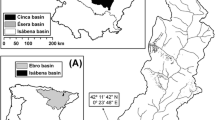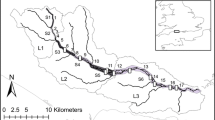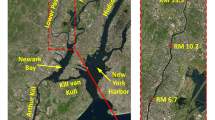Abstract
Flow regulation is widely recognized as affecting fluvial processes and river ecosystems. Most impact assessments have focused on large dams and major water transfer schemes, so relatively little is known about the impacts of smaller dams, weirs and water diversions. This paper assesses sediment dynamics in an upland river (the Ehen, NW England) whose flows are regulated by a small weir and tributary diversion. The river is important ecologically due to the presence of the endangered freshwater pearl mussel Margaritifera margaritifera, a species known to be sensitive to sedimentary conditions. Fine sediment yield for the 300-m long study reach was estimated to be 0.057 t km−2 year−1, a very low value relative to other upland UK rivers. Mean in-channel storage of fine sediment was also low, estimated at an average of around 40 g m−2. Although the study period was characterized by frequent high flow events, little movement of coarser bed material was observed. Data therefore indicate an extremely stable fluvial system within the study reach. The implication of this stability for pearl mussels is discussed.






Similar content being viewed by others
Notes
Keppel’s modified Bonferroni correction (Keppel 1991) was applied as it is less conservative and has a smaller impact on statistical power. It is calculated as (df*α)/k, where df is degree of freedom, α is the P value, and k is the number of tests.
References
Acreman M, Dunbar MJ (2004) Defining environmental river flow requirements—a review. Hydrol Earth Syst Sci 8:861–876. doi:10.5194/hess-8-861-2004
Allan JD, Castillo MM (2007) Stream Ecology, 2nd edn. Springer, AA Dordrecht, p 436
Arvidsson B, Österling M, Hultman J (2006) Recruitment of populations of freshwater pearl mussels (Margaritifera margaritifera) in relation to mussel population size and host density. In: Österling M (dissertation) Ecology of freshwater pearl mussels in disturbed environments, Karlstad Universitet. ISBN 91-7063-084-4
Asselman NEM (1999) Suspended sediment dynamics in a large drainage basin: the River Rhine. Hydrol Process 13:1437–1450. doi:10.1002/(SICI)1099-1085(199907)13
Batalla RJ, Vericat D (2011) A review of sediment quantity issues: examples from the River Ebro and adjacent basins (Northeastern Spain). Integr Environ Assess Manag 7:256–268. doi:10.1002/ieam.126
Batalla RJ, Gomez CM, Kondolf GM (2004) Reservoir-induced hydrological changes in the Ebro River basin (Northeastern Spain). J Hydrol 290:117–136. doi:10.1016/j.jhydrol.2003.12.002
Bilotta GS, Brazier RE (2008) Understanding the effects of suspended solids on water quality and aquatic biota. Water Res 42:2849–2861. doi:10.1016/j.watres.2008.03.018
Bilotta GS, Burnside NG, Cheek L, Dunbar MJ, Grove MK, Harrison C, Joyce C, Peacock C, Davy-Bowker J (2012) Developing environment-specific water quality guidelines for suspended particulate matter. Water Res 46:2324–2332. doi:10.1016/j.watres.2012.01.055
Birkel C, Soulsby C, Ali G, Tetzlaff D (2013) Assessing the cumulative impacts of hydropower regulation on the flow characteristics of a large atlantic salmon river system. River Res Appl. doi:10.1002/rra.2656
Brainwood M, Burgin S, Byrne M (2008) The impact of small and large impoundments on freshwater mussel distribution in the Hawkesbury-Nepean River, southeastern Australia. River Res Appl 24:1325–1342. doi:10.1002/rra.1087
Brown D, Butterill G, Bayliss B (2008) Ben Ghyll Geomorphology Report. Environment Agency Version 2. Penrith. p 25
Buddensiek EVH, Fleischauer-Rossing S, Wachtler K (1993) Studies on the chemistry of interstitial water taken from defined horizons in the fine sediments of bivalve habitats in several northern German lowland waters II; Microhabitats of Margaritifera margaritifera L., Unio crassus (Philipsson) and Unio tumidus (Philipsson). Arch für Hydrobiol 127:151–166
Buendia Fores C, Gibbins CN, Vericat D, Batalla RJ, Douglas A (2013) Detecting the structural and functional impacts of fine sediment on stream invertebrates. Ecol Indic 25:184–196. doi:10.1016/j.ecolind.2012.09.027
Buendia C, Gibbins CN, Vericat D, Lopez-Tarazon J, Batalla RJ (2011) Influence of naturally high fine sediment loads on aquatic insect larvae in a montane river. Scott Geogr J 127:315–334. doi:10.1080/14702541.2012.670006
Canadian Council of Ministers for the Environment (2002) Canadian water quality guidelines for the protection of aquatic life: Total particulate matter. In: Canadian environmental quality guidelines 1999 (updated 2002). Winnipeg. p 13
Cascade (2013) Ben Gill Realignment: Habitats Regulations Assessment and Ecological Impact Assessment. Report for United Utilities CC535. Cascade, Manchester. p 100
Charlton R (2007) Fundamentals of fluvial geomorphology. Routledge, London, p 234
Chin A, Laurencio LR, Martiniz AE (2008) The hydrologic importance of small- and medium-sized dams: examples from Texas. Prof Geogr 60:238–251. doi:10.1080/00330120701836261
Church M, Hassan MA (1992) Size and distance of travel of unconstrained clasts on a streambed. Water Resour Res 28:299–303. doi:10.1029/91WR02523
Degerman E, Alexanderson S, Bergengren J, Henrikson JL, Johansson BE, Larsen BM, Söderberg H (2009) Restoration of freshwater pearl mussel streams. Solna, WWF Sweden, p 64
Eder A, Strauss P, Krueger T, Quinton JN (2010) Comparative calculation of suspended sediment loads with respect to hysteresis effects (in the Petzenkirchen catchment, Austria). J Hydrol 389:168–176. doi:10.1016/j.jhydrol.2010.05.043
Ferguson RI, Wathen SJ (1998) Tracer-pebble movement along a concave river profile: virtual velocity in relation to grain size and shear stress. Water Resour Res 34:2031–2038. doi:10.1029/98WR01283
Geist J (2010) Strategies for the conservation of endangered freshwater pearl mussels (Margaritifera margaritifera L.): a synthesis of conservation genetics and ecology. Hydrobiol 644:69–88. doi:10.1007/S10750-010-0190-2
Geist J, Auerswald K (2007) Physiochemical stream bed characteristics and recruitment of the freshwater pearl mussel (Margaritifera margaritifera). Freshw Biol 52:2299–2316. doi:10.111/j.1365-2427.2007.01812.x
Gibbins C, Young M, Hastie LC, Soulsby C, Pokrajac D, Campbell L (2004) River Ehen Freshwater Pearl Mussel Project: Contract No JB128. Aberdeen University, Unpublished report to English Nature and the Environment Agency, p 44
Gibbins CN, Vericat D, Batalla R (2010) Relations between invertebrate drift and flow velocity in sand-bed and riffle habitats and the limits imposed by substrate stability and benthic density. J N Am Benthol Soc 29:945–958. doi:10.1899/09-096.1
Gilvear DJ (2004) Patterns of channel adjustment to impoundment of the Upper River Spey, Scotland (1942-2000). River Res Appl 20:151–165. doi:10.1002/rra.741
Gippel CJ (1995) Potential of turbidity monitoring for measuring the transport of suspended solids in streams. Hydrol Process 9:83–97. doi:10.1002/hyp.3360090108
Grabarkiewicz J, Davis W (2008) An introduction to freshwater mussels as biological indicators. EPA-260-R08-015. U.S. Environmental Protection Agency, Office of Environmental Information, Washington, DC
Graf W (2005) Geomorphology and Americam Dams: the scientific, social, and economic context. Geomorphol 71:3–26. doi:10.1016/j.geomorph.2004.05.005
Greig SM, Sear DA, Carling PA (2005) The impact of fine sediment accumulation on the survival of incubating salmon progeny: implications for sediment management. Sci Total Environ 344:241–258. doi:10.1016/j.scitotenv.2005.02.010
Greig SM, Sear DA, Carling PA (2007) A review of factors influencing the availability of dissolved oxygen to incubating salmonid embryos. Hydrol Process 21:323–334. doi:10.1002/hyp.6188
Hastie LC, Cosgrove PJ (2001) The decline of migratory salmonid stocks: a new threat to pearl mussels in Scotland. Freshw Forum 15:85–96
Hastie LC, Young MR (2003) Conservation of the Freshwater Pearl Mussel 2. Relationship with Salmonids. Conserving Natura 2000 Rivers Conservation Techniques Series No. 3. English Nature, Peterborough. p 48
Hastie LC, Boon PJ, Young MR (2000) Physical microhabitat requirements of freshwater pearl mussels, Margaritifera margaritifera (L.). Hydrobiol 429:59–71. doi:10.1023/A:1004068412666
Hudson R (2001) Interpreting turbidity and suspended sediment measurements in high energy streams in coastal British Columbia. Vancouver Forest Region, For Res Tech Rep, p 16
Jackson HM, Gibbins CN, Soulsby C (2007) Role of discharge and temperature variation in determining invertebrate community structure in a regulated river. River Res Appl 23:651–669. doi:10.1002/rra.1006
Jones JB, Holmes RM, Fisher SG, Grimm NB (1994) Chemoautotrophic production and respiration in the hyporheic zone of a Sonoran desert stream. In: Stanford JA, Valett HM (eds) Proceedings of 2nd International Conference on Groundwater Ecology. Am Water Res, Bethesda, pp 329–338
Jones JI, Collins AL, Naden PS, Sear DA (2012) The relationship between fine sediment and macrophytes in rivers. River Res Appl 28:1006–1018. doi:10.1002/rra.1486
Julian JP, Doyle MW, Powers SM, Stanley EH, Riggsbee JA (2008) Optical water quality in rivers. Water Resour Res 44:W10411. doi:10.1029/2007WR006457
Kelner DE, Sietman BE (2000) Relic populations of the ebony shell, Fusconaia ebena (Bivalvia: Unionidae), in the upper Mississippi River drainage. J Freshw Ecol 15:371–377. doi:10.1080/02705060.2000.9663755
Keppel G (1991) Design and analysis: a researcher handbook. Prentice Hall, Englewood Cliffs
Kondolf M (1997) Hungry water: effects of dams and gravel mining on river channels. Environ Manag 21:533–551. doi:10.1007/s002679900048
Lambert CP, Walling DE (1988) Measurement of channel storage of suspended sediment in a gravel bed river. Catena 15:65–80
Lawler DM, Wright LJ (1996) Sediment yield decline and climate change in southern Iceland. Erosion and sediment yield: global and regional perspectives. In: Proceedings of the Exeter Symposium, July 1996. IAHS 236
Lawler DM, Petts GE, Foster IDL, Harper S (2006) Turbidity dynamics during spring storm events in an urban headwater river system: The Upper Tame, West Midlands, UK. Sci Total Environ 360:109–126. doi:10.1016/j.scitotenv.2005.08.032
Liébault F, Bellot H, Chapuis M, Klotz S, Deschâtres M (2012) Bedload tracing in a high-sediment-load mountain stream. Earth Surf Process Landf 37:385–399. doi:10.1002/esp.2245
López-Tarazón JAL, Batalla R, Vericat D (2011) In-channel sediment storage in a highly erodible catchment: the River Isábena (Ebro Basin, Southern Pyrenees). Z für Geomorphol 55:365–382. doi:10.1127/0372-8854/2011/0045
Magilligan FJ, Haynie HJ, Nislow KH (2008) Channel adjustments to dams in the Connecticut river basin: implications for forested mesic watersheds. Ann Assoc Am Geogr 98:267–284. doi:10.1080/00045600801944160
Malcolm IA, Greig SM, Youngson AF, Soulsby C (2008) Hyporheic influences on salmon embryo survival and performance. Am Fish Soc Symp 65:225–248
Malcolm IA, Soulsby C, Youngson AF, Tetzlaff D (2009) Fine scale spatial and temporal variability of hyporheic hydrochemistry in salmon spawning gravels with contrasting groundwater-surface water interactions. Hydrogeol J 17:161–174. doi:10.1007/s10040-008-0339-5
Malcolm IA, Middlemas CA, Soulsby C, Middlemas SJ, Youngson AF (2010) Hyporheic zone processes in a canalised agricultural stream: implications for salmonid embryo survival. Fundamental Applied Limnology. Arch für Hydrobiol 176:319–336. doi:10.1127/1863-9135/2010/0176.0319
Marking LL, Bills TD (1979) Acute effects of silt and sand sedimentation on freshwater mussels. In: Rasmussen JR (ed) Proceedings of the UMRCC symposium on Upper Mississippi River bivalve molluscs. Upper Mississippi River Conservation Committee, Rock Island, pp 204–211
Moir HJ, Gibbins CN, Soulsby C (2003) River Ehen pearl mussel project: fluvial audit. Project report for English Nature Contract JB 128. University of Aberdeen, p 26
Montgomery DR, Buffington JM (1993) Channel classification prediction of channel response, and assessment of channel condition. Report TFW-SH10-93-002 prepared for the SHAMW committee of the Washington State Timber/Fish/Wildlife Agreement 107. University of Washington, Seattle
Morehead MD, Syvitski JP, Hutton EWH, Peckham SD (2013) Modelling the temporal variability in the flux of sediment from ungauged river basins. Glob Planet Change 39:95–110. doi:10.1016/S0921-8181(03)00019-5
Mukundan R, Pierson DC, Schneiderman EM, O’Donnell DM, Pradhanang SM, Zion MS, Matonse AH (2013) Factors affecting storm event turbidity in a New York City water supply stream. Catena 107:80–88. doi:10.1016/j.catena.2013.02.002
Newton TJ, Woolnough DA, Strayer DL (2008) Using landscape ecology to understand and manage freshwater mussel populations. J N Am Benthol Soc 27:424–439. doi:10.1899/07-076.1
Nistor CJ, Church M (2005) Suspended sediment transport regime in a debris-flow gully on Vancouver Island, British Columbia. Hydrol Process 19:861–885. doi:10.1002/hyp.5549
O’Leary D (2013) Pearls in Peril LIFE + GB: Action A3: Conservation Actions for the Freshwater Pearl Mussel in the River Ehen, Cumbria. Report LIFE 11 NAT/UK/383. West Cumbria Rivers Trust, UK
Oeurng C, Sauvage S, Sánchez-Pérez JM (2010) Dynamics of suspended sediment transport and yield in a large agricultural catchment, southwest France. Earth Surf Process Landf 35:1289–1301. doi:10.1002/esp.1971
Österling EM, Bergman E, Greenberg LA, Baldwin BS, Mills EL (2007) Turbidity-mediated interactions between invasive filter-feeding mussels and native bioturbing mayflies. Freshw Biol 52:1602–1610. doi:10.1111/j.1365-2427.2007.01791.x
Österling ME, Greenburg LA, Arvidsson BL (2008) Relationship of biotic and abiotic factors to recruitment patterns in Margaritifera margaritifera. Biol Conserv 141:1365–1370. doi:10.1016/j.biocon.2008.03.004
Österling ME, Arvidsson BL, Greenberg LA (2010) Habitat degradation and the decline of the threatened mussel Margaritifera margaritifera: influence of turbidity and sedimentation on the mussel and its host. J Appl Ecol 47:759–768. doi:10.1111/j.1365-2664.2010.01827.x
Owens PN, Walling DE, Leeks GJL (1999) Deposition and storage of fine-grained sediment within the main channel system of the River Tweed, Scotland. Earth Surf Process Landf 24:1061–1076. doi:10.1002/(SICI)1096-9837(199911)24:12
Parker G (1976) On the cause and characteristic scales of meandering and braiding in rivers. J Fluid Mech 76:457–480. doi:10.1017/S0022112076000748
Parkhill KL, Gulliver JS (2002) Effect of inorganic sediment on wholestream productivity. Hydrobiol 472:5–17. doi:10.1023/A:1016363228389
Petticrew EL, Krein A, Walling DE (2007) Evaluating fine sediment mobilization and storage in a gravel-bed river using controlled reservoir releases. Hydrol Process 21:198–210. doi:10.1002/hyp.6183
Quesada S, Tena A, Guillén D, Ginebreda A, Vericat D, Martínez E, Navarro-Ortega A, Batalla RJ, Barceló D (2014) Dynamics of suspended sediment borne persistent organic pollutants in a large regulated Mediterranean river (Ebro, NE Spain). Sci Total Environ 473–474:381–390. doi:10.1016/j.scitotenv.2013.11.040
Quinlan E, Gibbins C, Malcolm I, Batalla R, Vericat D, Hastie L (2014) A review of the physical habitat requirements and research priorities needed to underpin conservation of the endangered freshwater pearl mussel Margaritifera margaritifera. Mar. Freshw. Ecosyst, Aquat Conserv. doi:10.1002/aqc.2484
Rosenburg DM, McCully P, Pringle CM (2000) Global-scale environmental effects of hydrological alterations: introduction. BioSci 50:746–751. doi:10.1641/0006-3568
Rovira A, Batalla RJ (2006) Temporal distribution of suspended sediment transport in a Mediterranean basin: the Lower Tordera (NE Spain). Geomorphology 79:58–71. doi:10.1016/j.geomorph.2005.09.016
Sear DA (1995) Morphological and sedimentological changes in a gravel-bed river following 12 years of flow regulation for hydropower. River Res Appl 10:247–264. doi:10.1002/rrr.3450100219
Sear DA, Malcolm MD, Thorne CR (2003) Guidebook of Applied Fluvial Geomorphology. R&D Technical Report FD1914. Defra, UK
Skinner A, Young M, Hastie LC (2003) Ecology of the Freshwater Pearl Mussel. Conserving Natura 2000 Rivers Ecology Series No.2. English Nature, Peterborough
Smith HG, Dragovich D (2008) Sediment budget analysis of slope-channel coupling and in-channel sediment storage in an upland catchment southeastern Australia. Geomorphology 101:643–654. doi:10.1016/j.geomorph.2008.03.004
Söderberg H, Norrgrann O, Törnblom J, Andersson K, Henrikson L, Degerman E (2008) Vilka faktorer ger svaga bestånd av flodpärlmussla? En studie av 111 vattendrag i Västernorrland. Länsstyrelsen i Västernorrland. Kultur- och Naturavdelningen 8:28
Tarr E (2008) The population structure and habitat requirements of the freshwater pearl mussel, Margaritifera margaritifera, in Scotland. Ph.D. thesis, University of Aberdeen. p 221
Tena A, Batalla RJ, Vericat D (2012a) Reach-scale suspended sediment balance downstream from dams in a large Mediterranean river. Hydrol Sci J 57:831–849. doi:10.1080/02626667.2012.681784
Tena A, Książek L, Batalla RJ, Vericat D (2012b) Assessing the geomorphic effects of a flushing flow in a large regulated river. River Res Appl 29:876–890. doi:10.1002/rra.2572
Valovirta I (1998) Conservation of Margaritifera margaritifera in Finland. J Conchol Special Issue 2:251–256
Vericat D, Batalla RJ, Garcia C (2006) Breakup and reestablishment of the armor layer in a large gravel-bed river below dams: the lower Ebro. Geomorphology 76:122–136. doi:10.1016/j.geomorph.2005.10.005
Walling DE (1983) The sediment delivery problem. J Hydrol 64:209–237. doi:10.1016/0022-1694(83)90217-2
Walling DE, Amos CM (1999) Source, storage and mobilization of fine sediment in a chalk stream system. Hydrol Process 13:323–340. doi:10.1002/(SICI)1099-1085(19990228)13:3
Walling DE, Quine TA (1993) Using Chernobyl-derived radionuclides to investigate the role of downstream conveyance losses in the suspended sediment budget of the River Severn, UK. Phys Geogr 14:239–253. doi:10.1080/02723646.1993.10642478
Walling DE, Owens PN, Leeks GJL (1998) The role of channel and floodplain storage in the suspended sediment budget of the River Ouse, Yorkshire, UK. Geomorphol 22:225–242. doi:10.1016/S0169-555X(97)00086-X
Walling DE, Russell MA, Hodgkinson RA, Zhang Y (2002) Establishing sediment budgets for two small lowland agricultural catchments in the UK. Catena 47:323–353. doi:10.1016/S0341-8162(01)00187-4
Whiting PJ, King JG (2003) Surface particle sizes on armoured gravel streambeds: effects of supply and hydraulics. Earth Surf Process Landf 28:1459–1471. doi:10.1002/esp.1049
Williams GP (1989) Sediment concentration versus water discharge during single hydrologic events in rivers. J Hydrol 111:89–106. doi:10.1016/0022-1694(89)90254-0
Wolman MG (1954) A method of sampling coarse river-bed material. Trans Am Geophys Union 35:951–956
Wood PJ, Armitage PD (1997) Biological effects of fine sediment in the lotic environment. Environ Manag 21:203–217. doi:10.1007/s002679900019
Worrall F, Burt TP, Howden NJK (2013) The flux of suspended sediment from the UK 1974 to 2010. J Hydrol 504:29–39. doi:10.1016/j.jhydrol.2013.09.012
Young MR, Hastie LC, Al-Mousawi B (2001) What represents an ‘ideal’ population profile for Magaritifera margaritifera? In: Bauer G (ed) The freshwater pearl mussel in Europe: population status and conservation strategies. Hof, Germany
Acknowledgments
This work was funded by the Environment Agency (UK), whose support we gratefully acknowledge. We particularly thank Jane Atkins and Gail Butterill of the Environment Agency for their help and support. The fourth author has a Ramon y Cajal Fellowship (RYC-2010-06264) funded by the Spanish Ministry of Science and Innovation. Authors acknowledge the support from the Economy and Knowledge Department of the Catalan Government through the Consolidated Research Group 2014 SGR 645 (RIUS-Fluvial Dynamics Research Group).
Conflict of interest
The authors declare that they have no conflict of interest.
Ethical standards
The authors declare that the experiments for this research comply with the current laws of the country in which they were performed.
Author information
Authors and Affiliations
Corresponding author
Rights and permissions
About this article
Cite this article
Quinlan, E., Gibbins, C.N., Batalla, R.J. et al. Impacts of Small Scale Flow Regulation on Sediment Dynamics in an Ecologically Important Upland River. Environmental Management 55, 671–686 (2015). https://doi.org/10.1007/s00267-014-0423-7
Received:
Accepted:
Published:
Issue Date:
DOI: https://doi.org/10.1007/s00267-014-0423-7




